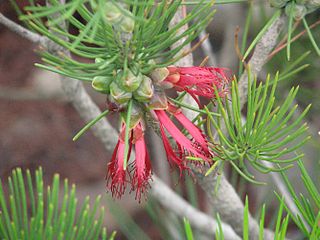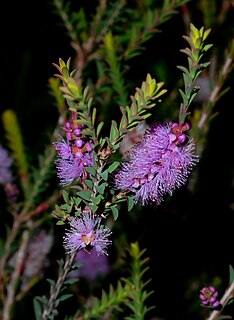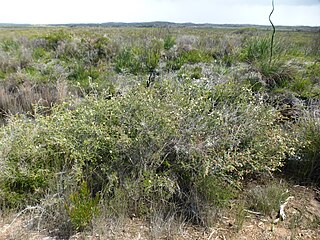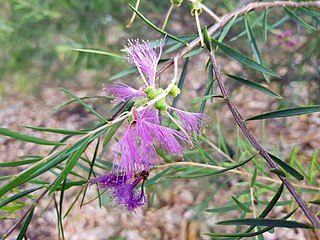
Melaleuca viminea, commonly known as mohan is a plant in the myrtle family Myrtaceae and is endemic to the south-west of Western Australia. It is variable in size and form from a densely branched, small shrub to a small tree. It has become naturalised locally in southern Victoria.

Melaleuca fulgens, commonly known as the scarlet honey myrtle, is a plant in the myrtle family Myrtaceae, and is endemic to Western Australia, South Australia and the Northern Territory. It is notable for its showy orange, red or purple flowers, unusual foliage and fruit, and is a popular garden plant. It is a member of Melaleuca, a large and diverse genus whose members range from large trees such as M. quinquenervia, to small shrubs.

Melaleuca williamsii is a plant in the myrtle family, Myrtaceae and is endemic to an area between north-eastern New South Wales and south eastern Queensland in Australia. It is a distinctive shrub with stiff branches, silvery new growth, prickly leaves and spikes of purple flowers in late spring. It is classified as a vulnerable species under the Australian Government Endangered Species Protection Act.
Melaleuca penicula is a plant in the myrtle family, Myrtaceae and is endemic to the south of Western Australia. It is a rare species only known from the Fitzgerald River National Park and resembles Melaleuca eximia with its spikes of red flowers but its leaves and stamen bundles are different.
Melaleuca eximia is a plant in the myrtle family, Myrtaceae and is endemic to the south of Western Australia. It is distinguished by its leaf arrangement, its large, showy red inflorescences and the large, furry bracts under the flowers.

Melaleuca monantha is a plant in the myrtle family, Myrtaceae and is endemic to an area in Queensland, Australia. It is a shrub, similar to Melaleuca minutifolia with very small leaves but the leaves lack oil glands and its flowers occur singly, rather than in pairs. It is also similar to Melaleuca sylvana but is usually multi-stemmed and has a more dense crown than that species.

Calothamnus graniticus, commonly known as granite claw flower, is a plant in the myrtle family, Myrtaceae and is endemic to the south-west of Western Australia. There are two subspecies, both of which have been classified as "near threatened". It is an erect, rounded shrub with pine-like, dark, grey-green foliage and usually bright red flowers. Calothamnus graniticus subsp. graniticus occurs in the Leeuwin-Naturaliste National Park and is the floral emblem of the nearby city of Busselton.

Melaleuca decussata, commonly known as cross-leaf honey-myrtle or totem poles, is a plant in the myrtle family, Myrtaceae native to South Australia and both native and naturalised in Victoria. It is an adaptable shrub, grown in many parts of Australia for its attractive foliage but is regarded as an environmental weed in parts of Victoria.
Melaleuca adenostyla is a plant in the myrtle family, Myrtaceae and is endemic to the south-west of Western Australia. It is a large, broom-like shrub to about 5 metres (16 ft) high with narrow leaves and cream-coloured flowers and which often grows in saline places.

Melaleuca coccinea, commonly known as the goldfields bottlebrush is a shrub in the myrtle family Myrtaceae and is endemic the south of Western Australia. It is distinguished by its unusual foliage and bottlebrush spikes of red flowers.

Melaleuca calycina is a shrub in the myrtle family, Myrtaceae, and is endemic to the south-west of Western Australia. It is a stiff, erect shrub with oval to heart-shaped leaves, white flowers and star-shaped fruit.

Melaleuca incana subsp. incana, commonly known as grey honey-myrtle, is a plant in the myrtle family Myrtaceae which is endemic to the south-west of Western Australia and is naturalised in the south of Victoria in Australia. It is commonly grown as a garden plant and produces large numbers of white or creamy yellow flowers in early spring.

Melaleuca incana subsp. tenella is a plant in the myrtle family Myrtaceae which is endemic to the south coast of Western Australia. It was formerly known as Melaleuca tenella Benth. but was reduced to a subspecies in 1998. It is similar to M. incana subsp. incana except in the form of the plant, the size and shape of its leaves, its flowering time and distribution.
Melaleuca pritzelii is a plant in the myrtle family, Myrtaceae, and is endemic to the south-west of Western Australia. It was originally named in 1923 by Karel Domin as a subspecies Melaleuca densa var. pritzelii but raised to species status in 1992. It is a rare species, known only from a few plants in each of a small number of populations.

Melaleuca scabra, commonly known as rough honey-myrtle, is a species of shrub that is endemic to a small area on the south coast of Western Australia. It has warty leaves and profuse, pink to purple heads of flowers between July and November.

Melaleuca spectabilis is a plant in the myrtle family, Myrtaceae, and is endemic to the south-west of Western Australia. It was formerly known as a subspecies of Melaleuca longistaminea. It is a low, prickly shrub with yellow or lime-green flowers in spring and early summer.
Melaleuca calcicola is a plant in the myrtle family, Myrtaceae and is endemic to the south of Western Australia. It was formerly known as a subspecies of Melaleuca apodocephala but was reassessed in 2010 and raised to species status. Its branches are corky, the leaves pointed although not prickly and the flowers are creamy white, tipped with yellow.

Melaleuca fulgens subsp. steedmanii, commonly known as the scarlet honey myrtle, is a plant in the myrtle family, Myrtaceae and is endemic to the south-west of Western Australia. In 1990, the species Melaleuca fulgens was separated into 3 subspecies. Of the two subspecies occurring in the south-west, this one has the narrower distribution, occurring mainly near Geraldton. As with the other subspecies, this one is notable for its showy flowers which are usually red but its foliage and fruits are also attractive features.
Melaleuca fulgens subsp. corrugata, commonly known as the wrinkled honey myrtle, is a plant in the myrtle family, Myrtaceae and is endemic to an area near the border between Western Australia, South Australia and the Northern Territory. In 1990, the species Melaleuca fulgens was separated into 3 subspecies. This subspecies has a disjunct distribution but is nevertheless very similar to the other two, only differing the colour of the flowers and small differences in the leaf shape and length of the stamens. As with the other subspecies, this one is notable for its showy flowers which are usually a shade of pink to mauve but its foliage and fruits are also attractive features.
Calothamnus gracilis is a plant in the myrtle family, Myrtaceae and is endemic to the south-west of Western Australia. It is a spreading shrub with upright foliage, common in heath within its range. It has long, thin leaves and produces dark red flowers at different times of the year, depending partly on rainfall. It is similar to Calothamnus gibbosus but lacks the corky bark on the older branches of that species and its flowers and fruit are not as deeply embedded in the bark.












